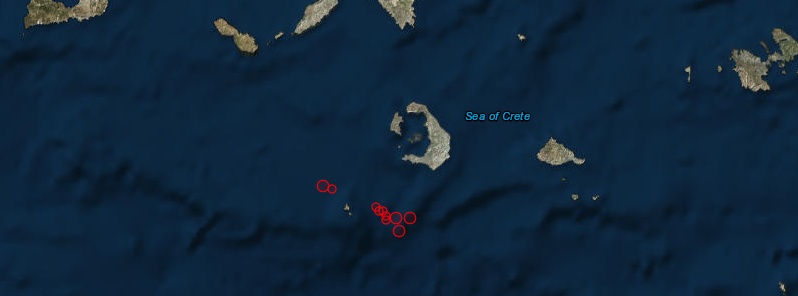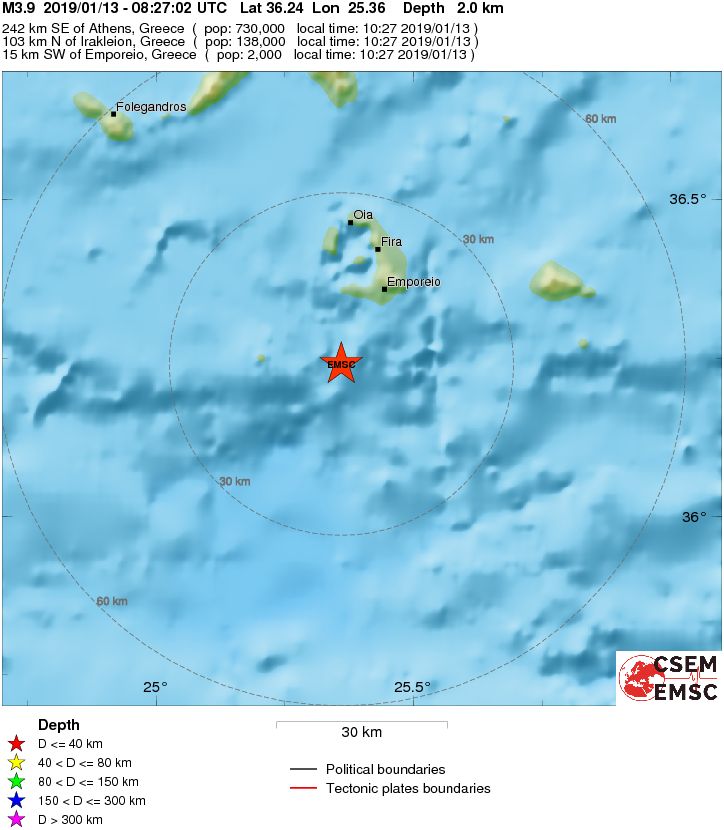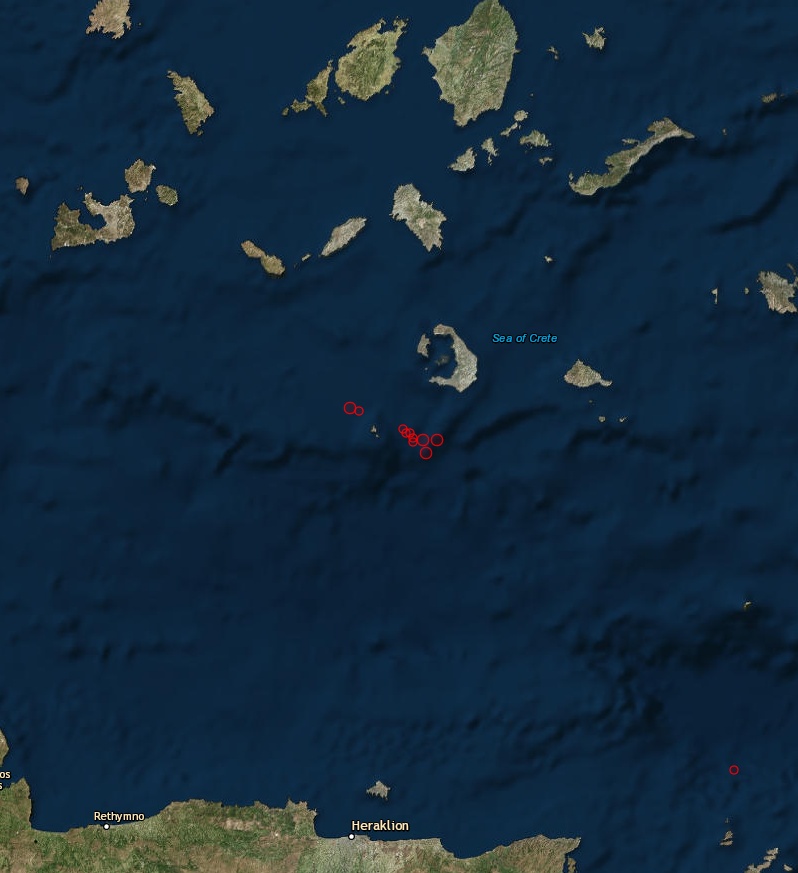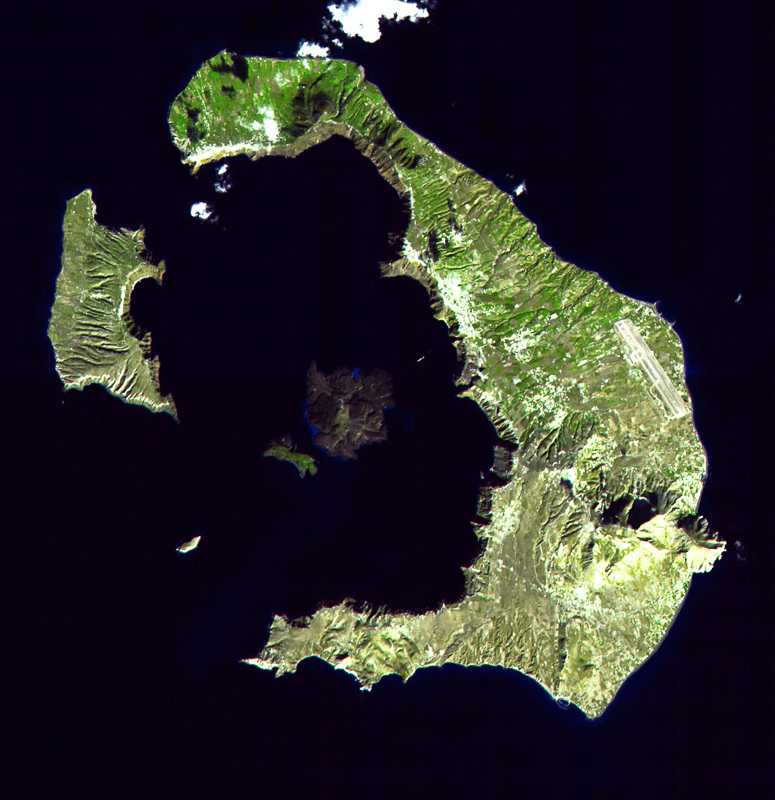Earthquake swarm near Santorini volcano, Greece

A seismic swarm started just SW of the Greek Santorini volcano on January 13, 2019. While there is currently no indication that the earthquakes are volcanic in origin, the situation merits close monitoring. The last eruption of this volcano took place in 1950 (VEI 2). A major catastrophic eruption (VEI 7) of this volcano took place in 1610 BCE (± 14 years). It was one of the largest volcanic events on Earth in recorded history.
According to data provided by the Hellenic Unified Seismic Network (H.U.S.N.), the swarm started at 02:50 UTC, January 13 with M2.5 earthquake at a depth of 13 km (8 miles).
This quake was followed by another M2.5 five minutes later and another 15 earthquakes by 15:44 UTC. Magnitudes ranged from 2.1 to 3.9 and depths from 8 to 17 km (5 – 10.5 miles). There were no other earthquakes registered in the area over the next 5 hours (time of press).
The strongest registered earthquake was M3.9 at 08:26 UTC (HUSN/EMSC), at a depth of 17 km (10.5 miles) according to HUSN, or 2 km (1.2 miles) according to EMSC. USGS reports it as M4.2 at a depth of 10 km (6.2 miles).

EMSC registered a total of 10 earthquakes in this area today, the first one as M2.9 at a depth of 8 km (5 miles).

Earthquakes near Santorini volcano, Greece on January 13, 2019. Credit: EMSC, TW
"The quakes are clustered about half way between Santorini's southwest end and the Christiana Island group," Dr. Tom Pfeiffer of the Volcano Discovery said.
"Although the quakes are near the Kameni line, a tectonic lineament in SW-NE direction which has been the preferred location for magma ascent (i.e. formation of volcanic vents) in the volcano's past few 100 000 years of history, there is currently no indication that the earthquakes are volcanic in origin," he said.
"It is much more likely that they represent a normal tectonic event. However, Santorini being both a popular tourist destination and an active volcano, the situation merits close monitoring."
The last eruptive phase of this volcano started on January 10, 1950 and ended on February 2 of the same year. The eruptive activity area was Nea Kameni (Liatsikas dome) (VEI2).

The dramatic mostly submerged caldera of Santorini volcano seen from space in this satellite image from NASA. The 11 x 7.5 km (6.8 x 4.6 miles) caldera was formed during at least four major explosive eruptions, the last of which occurred during the Bronze Age about 1650 BCE. The arcuate islands of Thira (right) and Therasia (left) form the outer flanks of the caldera. The darker area near the center of the caldera is Nea Kameni Island, which along with Palea Kameni Island to its left, is part of a post-caldera cone formed during historical eruptions dating back to 197 BCE. Credit NASA/ASTER
A major catastrophic eruption of this volcano in 1610 BCE (± 14 years), with a Volcanic Explosivity Index (VEI) of 7, is considered as one of the largest volcanic events on Earth in recorded history.
Geological summary
Renowned Santorini (Thera), with its steep-walled caldera rim draped by whitewashed villages overlooking an active volcanic island in the center of a caldera bay, is one of the scenic highlights of the Aegean.
The circular island group is composed of overlapping shield volcanoes cut by at least four partially overlapping calderas. The oldest southern caldera was formed about 180 000 years before present (BP), followed by the Skaros caldera about 70 000 years BP, and then the Cape Riva caldera about 21 000 years BP. The youngest caldera formed about 3 600 years BP during the Late-Bronze-Age Minoan eruption that forced abandonment of the thriving Aegean Sea island.
Post-Minoan eruptions beginning in 197 BCE constructed a series of lava domes and flows that form two islands near the center of the caldera. A submarine eruption took place in 1650 CE outside the caldera NE of Thera.
The latest eruption produced a small lava dome and flow in 1950, accompanied by explosive activity.
Featured image: Earthquake swarm near Santorini volcano, Greece on January 13, 2019. Credit: EMSC, TW

For Merle: Bollocks.
Le décalage de pôle magnétique indique l’accélération du cataclysme de la fin des temps
il a été récemment rapporté que le nord magnétique de la terre a accéléré son
changement le pôle nord de la terre s’est déplacé vers la sibérie depuis très longtemps
mais ce changement a fortement accéléré entre 1994 et 2002 environ 55 km par année
il a de nouveau accéléré incitant la première mise à jour du monde modèle magnétique
qui est utilisé pour la localisation et le suivi sur la surface de la terre le nord magnétique
le pôle se déplace aussi beaucoup plus vite que le pôle sud qui ne se déplace que sur
le taux d’environ 10 kilomètres par ans .Maintenant ce qui causerait le pôle nord à se
déplacer en premier lieu et d’autre part ce qui le ferait accélérer dans son mouvement
et nous savons que depuis 1998 le soleil est devenu sombre en raison du système planet X
accompagnées de leurs planètes et étoiles qui viennent dans le système solaire comme
les comètes les objets vont au soleil mais aussi vers la terre ils sont énormes .
le fait que le champ magnétique de la terre a accéléré correspond au moment où le soleil
est devenu noir en permanence le changement dans le champ magnétique de la terre était
associé à ces objets un grand système qui est arriver au soleil entre 1994 et 1998
le décalage du pôle magnétique semble être associé au système planet X ou destroyer
des objets affectant la terre et ses changement soudain suggère que plus d’objets sont arrivés
et sont maintenant en augmentation ils sont destructifs et causent des événements cataclysmiques
tel que des éruptions volcaniques que nous voyons maintenant à des niveaux sans précédent
mais ils causent aussi des séismes majeurs des ondes de marée des changements climatiques tel
que les tempêtes les ouragans les cyclones les inondations tous ces événements ont considérablement augmenté
les effets vont maintenant atteindre et même créer un niveau destructeur ces objets en plus grand nombre
vont causés le cataclysme prophétisé ce ne sera pas aussi rapide instantané que la grande inondation au temps
de Noé nais nous sommes maintenant à la fin des temps et le temps nous est compté.